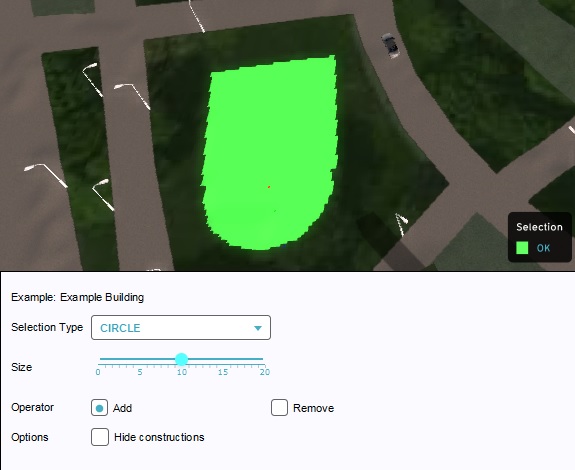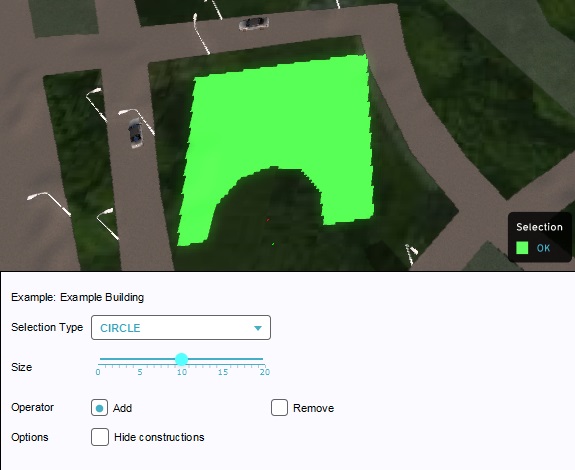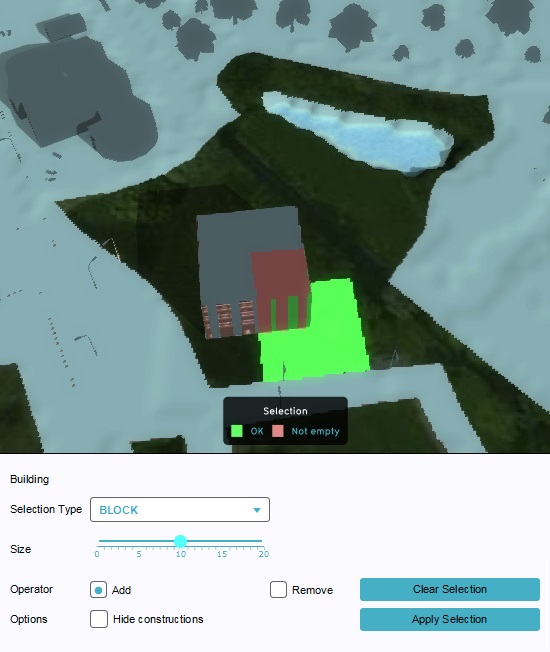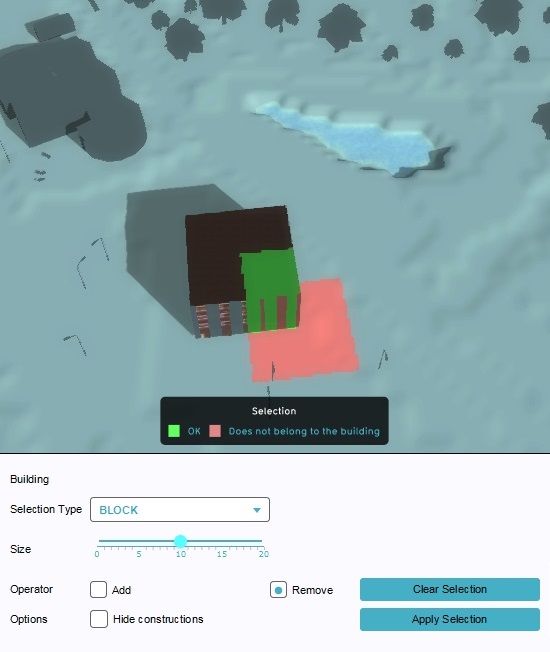Brush: Difference between revisions
| Line 38: | Line 38: | ||
Several selection types exist to allow you to draw in the 3D visualization. The default type depends on what you wish to draw. For example, when drawing a road, by default the brush will be set to "Line" mode. | Several selection types exist to allow you to draw in the 3D visualization. The default type depends on what you wish to draw. For example, when drawing a road, by default the brush will be set to "Line" mode. | ||
=====Block===== | =====Block===== | ||
: ''Use this mode to draw square or rectangular areas consisting of square blocks. When moving the cursor in the 3D visualization, a grid will become visible. This grid will align with nearby spatial elements, such as roads, allowing the user to draw a selection parallel or perpendicular to things already present in the project. Click a first time with the left mouse button to start the selection of a rectangle. Move the mouse to expand the rectangle in the desired direction. Click a second time to add the created rectangle to the current selection. Adjusting the size in the brush panel will make the grid larger or smaller.'' | |||
: ''Use this mode to draw square or rectangular areas consisting of square blocks. When moving the cursor in the 3D visualization, a grid will become visible. This grid will align with nearby spatial elements, such as roads, allowing the user to draw a selection parallel or perpendicular to things already present in the project. Click a first time with the left mouse button to start the selection of a rectangle. Move the mouse to expand the rectangle in the desired direction. Click a second time to add the created rectangle to the current selection. Adjusting the size in the brush panel will make the grid larger or smaller.'' | <gallery widths=100px heights=100px> | ||
[[File:Brush-block-first.png | First click]] | |||
[[File:Brush-block-first.png | Second click after cursor moved]] | |||
<gallery> | |||
=====Line===== | =====Line===== | ||
Revision as of 12:31, 19 January 2023
The brush is a tool in the editor, which allows you to make a 2 dimensional selection in the 3D Visualization of your project for a specific selected Item. Once satisfied with the selection, it has to be applied to add it to, or remove it from, the current 2 dimensional geometry of the selected item. While drawing a selection, feedback is given in form of colors, which are explained in the selection legend.
Brush Panel

The brush panel is not directly visible in the editor. Instead, it appears when it is required while using the editor. The brush options that are available for configuration depend on the type of Item, or component of an Item, you are using the brush for.
Brush options
The brush panel offers a number of options, which will allow you to accurately draw a selection in the 3D visualization.
Selection Type
- The type of selection you wish to make. This influences the shapes you draw in the 3D visualization. By using the right selection type, it is possible to make intricate selections, exactly reflecting your intentions.
Size
- The size of the selection you are drawing. Depending the current selection type, the size will influence how large your selection will be. A higher size allows you to draw greater selections more quickly, while a smaller size allows you to make your selection more detailed.
Operator
- The operation you wish to perform with your selection. Depending on what you are currently drawing a selection for, you may have the option to append to the existing spatial element, or to remove from it. For example, you can add to or remove from a building, but you cannot remove ownership, only overwrite it. By setting the operator to "Add", the selection (when applied) will be added to the spatial element. By setting it to "Remove", the selection (when applied) will be subtracted from the spatial element.
Options
- The options offer ways to make drawing easier. The currently available option is "Hide buildings", which will remove building from view. This allows you to draw your selection on the 3D visualization without obstructions.
How to use the brush
The brush panel will appear automatically when you need to draw in the 3D visualization. Depending on what you wish to draw, the brush will have several options available.
- Select the drawing mode you wish to use.
- If you wish to remove something, set "Remove" to "On".
- In the 3D visualization, click and hold down the left mouse button in a single location.
- While holding down the left mouse button, drag the cursor to another location in the 3D visualization.
- Release the mouse button to finish the selection.
- Press "Apply selection".
Brush functions explained
The brush panel will appear automatically when you need to draw in the 3D visualization. The Brush will automatically have certain options available or unavailable based on the specific thing you wish to draw. For example, if you wish to draw a road, you will only be able to do so in lines. If you wish to draw terrain, you do not have the option to remove the terrain, etc.
Drawing
There are several ways to draw using the brush. Depending on what you are drawing, the following options may be available. (Note that in the following description, selections are visualized on the client, but not yet applied to the project data. There will be no actual effect on the 3D visualization until the selection is explicitly applied.)
Selection Types
Several selection types exist to allow you to draw in the 3D visualization. The default type depends on what you wish to draw. For example, when drawing a road, by default the brush will be set to "Line" mode.
Block
- Use this mode to draw square or rectangular areas consisting of square blocks. When moving the cursor in the 3D visualization, a grid will become visible. This grid will align with nearby spatial elements, such as roads, allowing the user to draw a selection parallel or perpendicular to things already present in the project. Click a first time with the left mouse button to start the selection of a rectangle. Move the mouse to expand the rectangle in the desired direction. Click a second time to add the created rectangle to the current selection. Adjusting the size in the brush panel will make the grid larger or smaller.
-
Combining draw modes
-
Subtracting a selection
Validity
Making a selection is subject to validity. For more information on validity, please see Drawing validity.
Applying
When you have made a selection, you can use the "Apply Selection" button. At this point, the selection is used to place the Building, Zone, Area, ownership or anything else you might have been drawing, in the 3D Visualization.
Removing
The brush can often also be used to remove elements or properties from the 3D visualization. To do this, you can set the "Operator" setting to "Remove". You will notice your area for valid selections will be (partially) inverted. Places where you were unable to create a valid selection could now be valid, and places where you could make a valid selection will likely be invalid. This is because when you wish to remove something, you must be able to make a valid selection of it. While usually, when you wish to draw something, it cannot be placed again in the same place.
-
Validity of a selection when adding a building.
-
Validity of a selection when removing the building.
Clearing a selection
If you feel it necessary to cancel your current selection entirely and draw anew, you can use the "Clear Selection" button. This undoes the selection you have made and will not be applied, thus having no effect.



